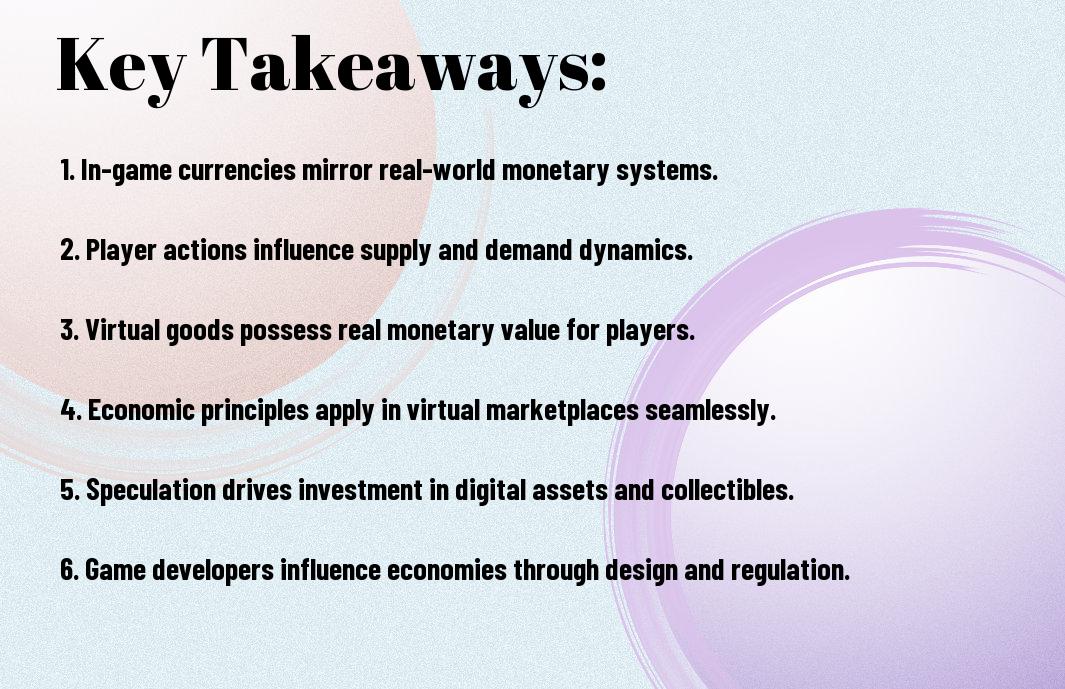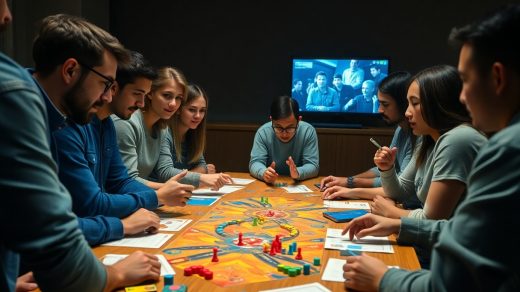As you explore virtual worlds, you may notice that in-game markets behave similarly to those in the real world. You can buy, sell, and trade virtual goods, influencing the economy within the game. Your actions, along with those of other players, drive supply and demand, mimicking the fundamental principles of economics. By examining these virtual economies, you can gain insight into how real-world markets function, making the virtual world a fascinating case study for understanding economic concepts.
Key Takeaways:
- Virtual economies in online games can mirror real-world economic principles, such as supply and demand, inflation, and scarcity, providing a unique lens to study economic behavior.
- In-game markets can be influenced by external factors like game updates, player demographics, and global events, similar to how real-world economies are affected by external factors.
- The trade of virtual goods and currencies can lead to the emergence of black markets, highlighting the challenges of regulating and managing virtual economies.
- Players’ behavior in virtual economies can be driven by psychological factors, such as emotional attachment to virtual items, social status, and the desire for instant gratification.
- Virtual economies can be used as a testing ground for economic theories and models, allowing researchers to simulate and analyze complex economic systems in a controlled environment.
- The study of virtual economies can provide insights into the potential applications and implications of emerging technologies, such as blockchain and cryptocurrency, in real-world economic systems.
- The intersection of virtual and real-world economies raises important questions about the nature of value, ownership, and the impact of technology on economic systems, highlighting the need for ongoing research and discussion.
Virtual Currency Fundamentals
To understand virtual economies, you need to grasp the basics of virtual currency, which is explored in-depth in The Economics of Virtual Economies: How Real Money Flows in Digital Worlds, a topic that sheds light on your understanding of digital transactions.
Digital Money Systems
Currencies in virtual worlds function similarly to real-world currencies, allowing you to purchase in-game items and services, and you can explore how these systems work in various online games.
Exchange Rates and Value Creation
Between the virtual and real-world economies, exchange rates play a significant role in determining the value of virtual currencies, and you can observe how these rates fluctuate based on supply and demand.
Further, as you investigate into the concept of exchange rates and value creation, you will notice that the value of virtual currencies is often tied to their usefulness within the game, as well as their scarcity, and you can analyze how these factors impact your in-game transactions and overall gaming experience.

Market Mechanics in Gaming
Some of the most interesting aspects of virtual economies can be found in the market mechanics that govern in-game trade. You’ll notice that these mechanics are designed to mimic real-world economic principles, allowing you to experience the thrill of buying and selling in a virtual environment.
Supply and Demand Forces
Along with the introduction of virtual currencies, you’ll find that supply and demand forces play a significant role in shaping the in-game economy. As you participate in these markets, you’ll see how the balance between supply and demand influences prices and trade.
Player-Driven Economics
Any time you engage with an in-game market, you’re contributing to a player-driven economy. You’ll have the opportunity to buy, sell, and trade items, shaping the economy with your actions and decisions.
This aspect of virtual economies is particularly fascinating, as it allows you to experience the consequences of your economic decisions in a low-stakes environment. As you navigate these player-driven economies, you’ll gain a deeper understanding of how your actions impact the market and the overall economy, giving you a unique perspective on real-world economic principles.

Digital Scarcity
Keep in mind that digital scarcity is a fundamental concept in virtual economies, as it creates value and drives demand for in-game items and resources. You’ll notice that game developers often implement mechanisms to control the supply of these resources, affecting your gameplay experience.
Resource Management
Among the various strategies you’ll employ in virtual economies, managing resources effectively is key to success. You’ll need to balance your in-game budget, prioritize spending, and make informed decisions about how to allocate your resources to achieve your goals.
Artificial Limitations
After entering a virtual economy, you’ll encounter artificial limitations that restrict your progress or access to certain items. You’ll find that these limitations can be frustrating, but they also create opportunities for strategic decision-making and innovation.
In addition to controlling the supply of resources, artificial limitations can also influence your behavior and interactions within the virtual economy. You’ll need to adapt to these limitations and find ways to overcome them, which can lead to a more engaging and immersive experience, as you navigate the challenges and opportunities presented by these restrictions, shaping your overall experience in the virtual world.
Trading Systems
Not surprisingly, trading systems are a fundamental component of virtual economies, allowing you to exchange goods and services with other players. You can participate in these systems, which are designed to mimic real-world markets, and learn about supply and demand.
Auction Houses
On entering an auction house, you’ll find a platform where you can buy and sell items with other players. You can browse listings, place bids, and purchase items, all within a virtual environment that simulates real-world market dynamics.
Peer-to-Peer Transactions
After engaging in peer-to-peer transactions, you’ll notice that they enable direct trade between players, without the need for intermediaries. You can negotiate prices and exchange items, which helps you understand the value of goods in the virtual economy.
Further, as you explore peer-to-peer transactions, you’ll discover that they offer a high degree of flexibility and freedom, allowing you to trade items that may not be available through other channels. You can also use this system to specialize in specific goods or services, and develop your own trading strategies, which can help you succeed in the virtual economy.
Economic Behaviors
Despite the virtual nature of in-game markets, you can observe similar economic behaviors as in the real world. You can learn more about this phenomenon in Virtual Economies in Gaming: Understanding the Impact of In-Game Currencies, which explores the intricacies of virtual economies.
Consumer Psychology
Any analysis of in-game markets must consider your consumer psychology, as your purchasing decisions are influenced by various factors, including perceived value and social status, which drive your behavior in virtual economies.
Investment Patterns
One key aspect of economic behaviors in virtual economies is your investment patterns, which can be shaped by factors such as risk tolerance and expected returns, influencing your decisions to invest in virtual assets.
At the heart of investment patterns in virtual economies lies the concept of value perception, where you assign value to virtual items based on their rarity, utility, or aesthetic appeal, and make investment decisions accordingly, which can have significant implications for your in-game wealth and overall gaming experience.
Real-World Parallels
Now, as you explore virtual economies, you’ll notice striking similarities with real-world markets, where supply and demand dictate prices and drive economic growth, allowing you to draw parallels between your in-game experiences and the global economy.
Inflation and Deflation
Above all, you’ll observe that virtual economies are susceptible to inflation and deflation, just like real-world economies, where an overabundance or scarcity of in-game currency can impact your purchasing power and influence your economic decisions.
Market Manipulation
Realistically, you should be aware that market manipulation can occur in virtual economies, where players may exploit glitches or manipulate markets to their advantage, affecting your gameplay and the overall economy, making it necessary to understand these dynamics to navigate your in-game world effectively.
A closer look at market manipulation in virtual economies reveals that you can experience a range of consequences, from price fixing to exploitation, which can have significant impacts on your gameplay and the overall health of the economy, making it necessary for you to be aware of these risks and take steps to protect your in-game assets and investments.
Summing up
With these considerations, you can see how virtual economies mirror real-world markets, offering insights into your economic behaviors and decision-making processes. As you explore in-game markets, you’ll notice similarities to your everyday financial interactions, from supply and demand to risk and reward. By examining your actions in virtual economies, you can gain a deeper understanding of your own economic tendencies and how they reflect broader economic principles.
FAQ
Q: What are virtual economies and how do they relate to real-world economics?
A: Virtual economies refer to the economic systems that exist within online games and virtual worlds. These economies are created by the interactions of players as they buy, sell, and trade virtual goods and services. Interestingly, these virtual economies reflect many aspects of real-world economics, including supply and demand, inflation, and even unemployment. The dynamics of virtual economies can provide valuable insights into how economic principles work in the real world, making them a fascinating area of study for economists and gamers alike.
Q: How do in-game markets reflect real-world economic principles, such as supply and demand?
A: In-game markets reflect real-world economic principles in several ways. For example, when a rare item is introduced into a game, its initial price may be high due to high demand and low supply. As more players acquire the item, the supply increases, and the price may decrease. This is a direct reflection of the law of supply and demand, where the price of a good is determined by the intersection of the supply and demand curves. Additionally, in-game markets can also experience inflation, where the amount of in-game currency increases, causing prices to rise. This can lead to players seeking alternative forms of currency or finding ways to exploit the system, mirroring real-world economic behaviors.
Q: What can be learned from studying virtual economies, and how can this knowledge be applied to real-world economic issues?
A: Studying virtual economies can provide valuable insights into human economic behavior, particularly in areas such as decision-making under uncertainty and the impact of policy interventions. By analyzing data from virtual economies, economists can test theories and models in a controlled environment, which can then be applied to real-world economic issues. For instance, understanding how players respond to changes in in-game economic policies can inform decisions on taxation, monetary policy, and regulation in the real world. Moreover, virtual economies can serve as a testing ground for new economic ideas and systems, allowing policymakers to simulate and evaluate different scenarios before implementing them in the real world.



